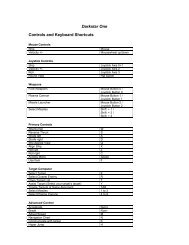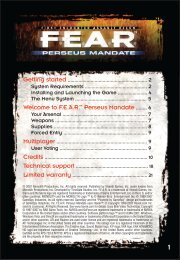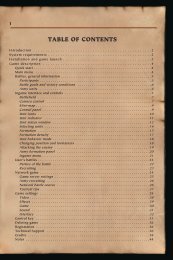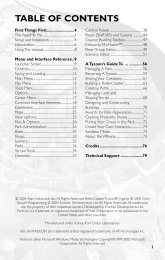Heads-Up Display Modes 35 - Metaboli
Heads-Up Display Modes 35 - Metaboli
Heads-Up Display Modes 35 - Metaboli
You also want an ePaper? Increase the reach of your titles
YUMPU automatically turns print PDFs into web optimized ePapers that Google loves.
Air Combat Basics 115<br />
AIR COMBAT BASICS<br />
Strategy and Tactics Overview<br />
Modern technology has completely revolutionized the battlefield in less than a<br />
century. Aircraft, in particular, have advanced from little more than motor-powered<br />
kites to modern combat jets in just a few decades. Defense contractors and<br />
military officials often cite the strengths of their vehicles, but rarely mention the<br />
major shortcomings in public. Consequently, many people develop an opinion that<br />
aircraft (and other battlefield platforms) are more capable than they really are.<br />
The primary reason flight-simulator pilots get shot down is inappropriate usage of<br />
their platform. Keep in mind that surface-to-air defenses and enemy aircraft have<br />
made the same technological leaps. True, today’s aircraft are significantly more<br />
powerful and resilient than their WWII counterparts; at the same time, enemy<br />
gunfire is much more accurate, powerful, and able to fire at longer ranges. In<br />
short, the battlefield is a more dangerous place than ever before.<br />
Understanding Enemy Air Defenses<br />
Enemy air defenses, including surface-to-air missiles and anti-aircraft artillery, are<br />
an integral part of the modern battlefield. Interlinked defense nets let defense<br />
sites across the battlefield communicate and share information. Pilots must<br />
possess a thorough knowledge of (and a strong respect for) such systems, or<br />
they’ll find themselves riding a parachute with alarming frequency.<br />
AAA<br />
In general, Anti-Aircraft Artillery (AAA) is effective against low-flying targets and<br />
mainly serves for covering troops from enemy aircraft. Many armies have multibarreled<br />
mobile AAA systems fitted with radar and a fire-control system that<br />
provide effective operation in any meteorological conditions. In contrast to ground<br />
forces, ship-borne artillery usually has a multipurpose character, and fighting<br />
against airborne targets is just one of their several functions.<br />
An AAA shell consists of a warhead, an impact fuse that detonates at the<br />
moment of contact with the target, and a “time fuse,” which detonates after a<br />
particular flight time. The target is generally destroyed by the fragments<br />
produced by the warhead on detonation.<br />
Land-based systems, like the ZSU-23-4 Shilka (pronounced ‘shil-ka’) employ mutlibarreled<br />
cannons, off-road mobility, and high rate of fire. Usually equipped with its<br />
own radar, self-propelled AAA usually has some backup aiming method, such as<br />
an IR or optical seeker.<br />
To destroy low-flying airborne targets, combat ships use multipurpose guns that<br />
can also be used against enemy ships and coastal defense. For the most part,<br />
shipborne artillery is classed as 100 to 130mm guns (heavy caliber), 57 to 76mm<br />
guns (medium caliber), and 20 to 40mm guns (small caliber). All guns have a high<br />
degree of automation of aiming, loading, and firing. Automatic small-caliber (20-<br />
40mm) anti-aircraft guns are mainly effective against low-flying aircraft and cruise<br />
missiles. Since SAMs normally have a substantial minimum range (within which<br />
airborne targets cannot be hit) ship-borne AAA is used as a short-ranged, point -<br />
defense weapon. Firing around 1,000 rpm per barrel, such weapons create a















